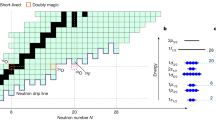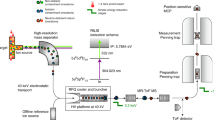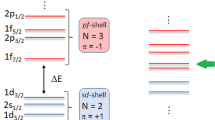Abstract
The atomic nucleus and its electrons are often thought of as independent systems that are held together in the atom by their mutual attraction. Their interaction, however, leads to other important effects, such as providing an additional decay mode for excited nuclear states, whereby the nucleus releases energy by ejecting an atomic electron instead of by emitting a γ-ray. This ‘internal conversion’ has been known for about a hundred years and can be used to study nuclei and their interaction with their electrons1,2,3. In the inverse process—nuclear excitation by electron capture (NEEC)—a free electron is captured into an atomic vacancy and can excite the nucleus to a higher-energy state, provided that the kinetic energy of the free electron plus the magnitude of its binding energy once captured matches the nuclear energy difference between the two states. NEEC was predicted4 in 1976 and has not hitherto been observed5,6. Here we report evidence of NEEC in molybdenum-93 and determine the probability and cross-section for the process in a beam-based experimental scenario. Our results provide a standard for the assessment of theoretical models relevant to NEEC, which predict cross-sections that span many orders of magnitude. The greatest practical effect of the NEEC process may be on the survival of nuclei in stellar environments7, in which it could excite isomers (that is, long-lived nuclear states) to shorter-lived states. Such excitations may reduce the abundance of the isotope after its production. This is an example of ‘isomer depletion’, which has been investigated previously through other reactions8,9,10,11,12, but is used here to obtain evidence for NEEC.
This is a preview of subscription content, access via your institution
Access options
Access Nature and 54 other Nature Portfolio journals
Get Nature+, our best-value online-access subscription
$29.99 / 30 days
cancel any time
Subscribe to this journal
Receive 51 print issues and online access
$199.00 per year
only $3.90 per issue
Buy this article
- Purchase on Springer Link
- Instant access to full article PDF
Prices may be subject to local taxes which are calculated during checkout



Similar content being viewed by others
References
Hamilton, J. H . (ed.) Internal Conversion Processes 1–13 (Academic Press Inc., 1966)
Blatt, J. M. & Weisskopf, V. F. Theoretical Nuclear Physics 614–622 (John Wiley & Sons, 1952)
Kibédi, T., Burrows, T. W., Trzhaskovskaya, M. B., Davidson, P. M. & Nestor, C. W. Jr. Evaluation of theoretical conversion coefficients using BrIcc. Nucl. Instrum. Methods A 589, 202–229 (2008)
Goldanskii, V. I. & Namiot, V. A. On the excitation of isomeric nuclear levels by laser radiation through inverse internal electron conversion. Phys. Lett. B 62, 393–394 (1976)
Morel, P ., Daugas, J. M ., Gosselin, G ., Méot, V. & Gogny, D. Nuclear excitation by electronic processes: NEEC and NEET effects. AIP Conf. Proc. 769, 1085–1088 (2005)
Pálffy, A., Evers, J. & Keitel, C. H. Isomer triggering via nuclear excitation by electron capture. Phys. Rev. Lett. 99, 172502 (2007)
Gosselin, G. & Morel, P. Enhanced nuclear level decay in hot dense plasmas. Phys. Rev. C 70, 064603 (2004)
Belic, D. et al. Photoactivation of 180Tam and its implications for the nucleosynthesis of nature’s rarest naturally occurring isotope. Phys. Rev. Lett. 83, 5242–5245 (1999)
Carroll, J. J . et al. Nuclear structure and depletion of nuclear isomers using electron linacs. AIP Conf. Proc. 1525, 586–594 (2013)
Roig, O. et al. Direct evidence for inelastic neutron “acceleration” by 177Lum. Phys. Rev. C 83, 064617 (2011)
Karamian, S. A. & Carroll, J. J. Cross section for inelastic neutron “acceleration” by 178Hfm2. Phys. Rev. C 83, 024604 (2011)
Stefanescu, I. et al. Coulomb excitation of 68,70Cu: first use of postaccelerated isomeric beams. Phys. Rev. Lett. 98, 122701 (2007)
Karamian, S. A. & Carroll, J. J. Calculated yield of isomer depletion due to NEEC for 93mMo recoils. Phys. At. Nucl. 75, 1362–1367 (2012)
Baglin, C. M. Nuclear data sheets for A = 93. Nucl. Data Sheets 112, 1163–1389 (2011)
Schiwietz, G. & Grande, P. L. Improved charge-state formulas. Nucl. Instrum. Methods B 175–177, 125–131 (2001)
Polasik, M. et al. Resonance conditions for 93mMo isomer depletion via nuclear excitation by electron capture in a beam-based scenario. Phys. Rev. C 95, 034312 (2017)
Lee, I.-Y. The Gammasphere. Nucl. Phys. A 520, c641–c655 (1990)
Anderson, J. T. et al. A digital data acquisition system for the detectors at Gammasphere. In IEEE Nuclear Science Symposium and Medical Imaging Conference 1536–1540 (IEEE, 2012)
Sethi, J. et al. Low-lying states near the Iπ = 6+ isomer in 108Ag. J. Phys. G 43, 015103 (2016)
Kimball, J. C., Bittel, D. & Cue, N. A comment on “nuclear excitation by target electron capture”. Phys. Lett. A 152, 367–370 (1991)
Yuan, Z.-S. & Kimball, J. C. First-principles calculation of the cross sections for nuclear excitation by electron capture of channeled nuclei. Phys. Rev. C 47, 323–328 (1993)
Gunst, J., Litvinov, Y. A., Keitel, C. H. & Pálffy, A. Dominant secondary nuclear photoexcitation with the x-ray free-electron laser. Phys. Rev. Lett. 112, 082501 (2014)
Gunst, J., Wu, Y., Kumar, N., Keitel, C. H. & Pálffy, A. Direct and secondary nuclear excitation with x-ray free-electron lasers. Phys. Plasmas 22, 112706 (2015)
Wu, Y ., Gunst, J ., Keitel, C. H . & Pálffy, A. Tailoring laser-generated plasmas for efficient nuclear excitation by electron capture. Preprint at https://arxiv.org/abs/1708.04826 (2017)
Thompson, I. J. Coupled reaction channels calculations in nuclear physics. Comput. Phys. Rep. 7, 167–212 (1988)
Cline, D. et al. GOSIA user manual for simulation and analysis of Coulomb excitation experiments, http://www.pas.rochester.edu/~cline/Gosia/Gosia_Manual_20120510.pdf (2012)
Hayes, A. B. & Cline, D. RACHEL graphical interface to GOSIA, https://github.com/adamhayes/Rachel (2017)
Tarasov, O. B. & Bazin, D. Development of the program LISE: application to fusion-evaporation. Nucl. Instrum. Methods B 204, 174–178 (2003)
McCutchan, E. A., Lister, C. J. & Greene, J. P. A target vacuum interlock system for Gammasphere. Nucl. Instrum. Methods A 607, 564–567 (2009)
Radford, D. C. Background subtraction from in-beam HPGe coincidence data sets. Nucl. Instrum. Methods A 361, 306–316 (1995)
Pálffy, A., Harman, Z. & Scheid, W. Quantum interference between nuclear excitation by electron capture and radiative recombination. Phys. Rev. A 75, 012709 (2007)
Fukuchi, T. et al. High-spin isomer in 93Mo. Eur. Phys. J. A 24, 249–257 (2005)
Hasegawa, M ., Sun, Y ., Tazaki, S ., Kaneko, K. & Mizusaki, T. Characteristics of the 21/2+ isomer in 93Mo: toward the possibility of enhanced nuclear isomer decay. Phys. Lett. B 696, 197–200 (2011)
Baglin, C. M. Nuclear data sheets for A = 92. Nucl. Data Sheets 113, 2187–2389 (2012)
Firestone, R. B. et al. (eds) Table of Isotopes 8th edn, Vol. II (John Wiley & Sons, 1996)
Radford, D. C. ESCL8R and LEVIT8R: software for interactive graphical analysis of HPGe coincidence data sets. Nucl. Instrum. Methods A 361, 297–305 (1995)
Acknowledgements
C.J.C. and J.J.C. thank A. D. Ayangeakaa for input on the potential contributions of Coulomb excitations to the background and M. S. Litz and N. R. Pereira for discussions. We also thank J. Rohrer for assistance in setting up the Gammasphere experiment and the ATLAS operations staff for their efforts. This work was initiated under the US Army Research Laboratory (ARL) Director’s Research Initiative, award number DRI-FY14-SE-022. Further support was provided by ARL Cooperative Agreements W911NF-12-2-0019 and W911NF-16-2-0034, the US Department of Energy (DOE), Office of Science, Office of Nuclear Physics under contract number DE-AC02-06CH11357, the National Science Foundation under grant number PHY-1203100, the Australian Research Council under grant number FT100100991, and the Polish National Science Centre under grants 2011/01/D/ST2/01286 and 2017/25/B/ST2/00901. M.P., J.R. and A.B.H. received support through Ecopulse, Inc. under ARL contract number W911QX09D0016-0004. This research used resources of Argonne National Laboratory’s ATLAS facility, which is a DOE Office of Science User Facility, and of the HIAF at ANU.
Author information
Authors and Affiliations
Contributions
C.J.C. led the experimental effort. The experiment was conceptualized by S.A.K. and J.J.C., with the final design provided by C.J.C. and J.J.C. with input from D.J.H. and G.J.L. The targets were prepared by J.P.G. All authors, except S.B., A.B.H. and S.A.K., participated in the experiment. C.J.C. analysed the data, with substantial input from J.J.C. Guidance on the atomic conditions for NEEC was provided by M.P. and J.R. The calculations of inelastic-scattering cross-sections with FRESCO were performed by S.B. and those of Coulomb excitation with GOSIA by A.B.H. We wish to call attention to the role of our late colleague S.A.K., who provided the initial impetus for this work but sadly did not see these results.
Corresponding author
Ethics declarations
Competing interests
The authors declare no competing financial interests.
Additional information
Reviewer Information Nature thanks O. Kocharovskaya and the other anonymous reviewer(s) for their contribution to the peer review of this work.
Publisher's note: Springer Nature remains neutral with regard to jurisdictional claims in published maps and institutional affiliations.
Extended data figures and tables
Extended Data Figure 1 Configuration of the target used in the experiment.
a, Schematic of the target construction showing the layers in which 93Mo production occurs (Li), NEEC can occur (C) and the backing that stops all recoils (208Pb), in addition to the important gap of about 3 mm that is needed to accommodate the effective half-life for the decay of the 4,900-keV level. Relative dimensions are not to scale. The beam is incident on the Li surface. b, Photograph of the target positioned inside the Gammasphere target chamber. The beam enters from the lower right side and is parallel to the double rods shown in the upper left part of the photograph.
Extended Data Figure 2 Spectra showing the line shape of the 2,475-keV transition in 93Mo.
a, b, The spectra are from the detectors in ring 9 of Gammasphere at 90° (a) and ring 7 at 79° (b). The spectra in red were recorded while using a Li target backed with 208Pb and with no gap in between. The blue spectra were obtained with a modified target configuration with a gap of about 3 mm. The 2,361-keV peak corresponds to a transition in 92Mo that lies below a level with a half-life of t1/2 = 35 ps. The similar line shapes of these two transitions support the estimate of a delay of tens of picoseconds in the 2,475-keV emission and therefore the rationale for the final target construction.
Extended Data Figure 3 Spectra used to determine background contributions.
Component spectra for the double gate on the Doppler-shifted 2,475-keV γ-ray (1) and the unshifted 1,478-keV γ-ray (2), where gates on the peak and background regions are denoted as ‘g’ and ‘b’, respectively (see text). a, g1g2. b, g1b2. c, b1g2. d, b1b2. Only those γ-rays in 93Mo relevant to the discussion are labelled, with the dashed lines marking their energies. We note that the 770-keV peak in a is a multiplet with the 773- and 777-keV transitions in 92Mo and 97Ru, respectively; only the last two peaks appear in b and d.
Extended Data Figure 4 Calculations of possible competing processes.
The inelastic-scattering cross-sections for exciting 93mMo to the intermediate state, calculated with the code FRESCO, are plotted versus the energy of recoiling 93Mo ions traversing the 7Li (blue) and 12C (red) target layers. The initial energy is the average recoil energy corresponding to 93Mo production at the centre of the Li target.
Rights and permissions
About this article
Cite this article
Chiara, C., Carroll, J., Carpenter, M. et al. Isomer depletion as experimental evidence of nuclear excitation by electron capture. Nature 554, 216–218 (2018). https://doi.org/10.1038/nature25483
Received:
Accepted:
Published:
Issue Date:
DOI: https://doi.org/10.1038/nature25483
This article is cited by
-
Photonuclear production of nuclear isomers using bremsstrahlung induced by laser-wakefield electrons
Nuclear Science and Techniques (2023)
-
Reply to: Possible overestimation of isomer depletion due to contamination
Nature (2021)
-
Possible overestimation of isomer depletion due to contamination
Nature (2021)
-
First on-line detection of radioactive fission isotopes produced by laser-accelerated protons
Scientific Reports (2020)
-
Attosecond coherent control of free-electron wave functions using semi-infinite light fields
Nature Communications (2018)
Comments
By submitting a comment you agree to abide by our Terms and Community Guidelines. If you find something abusive or that does not comply with our terms or guidelines please flag it as inappropriate.



